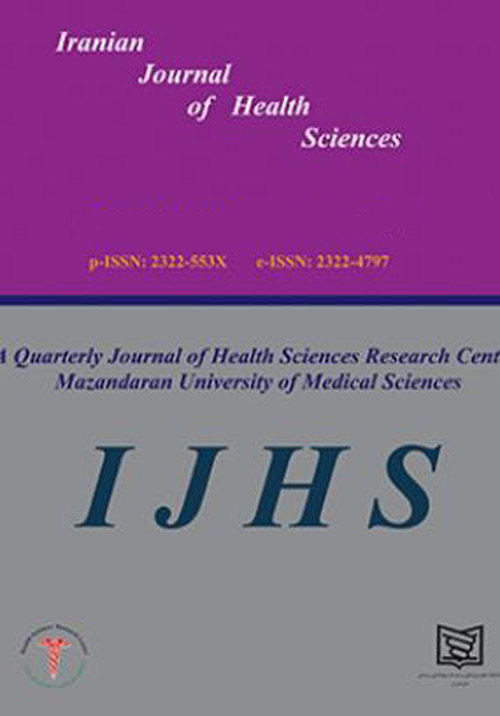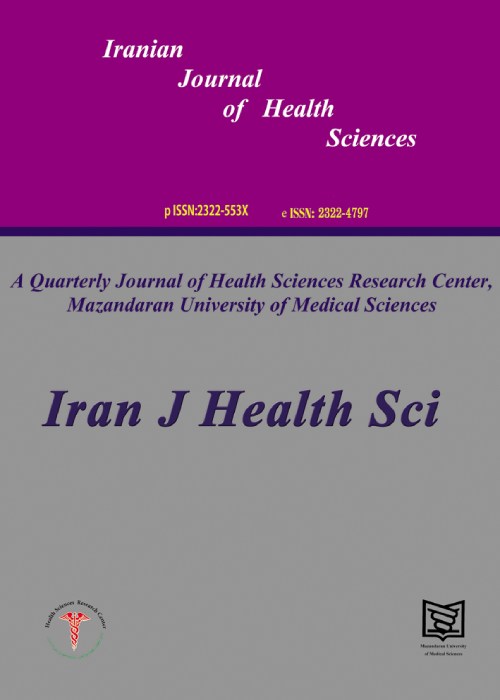فهرست مطالب

Iranian Journal of Health Sciences
Volume:7 Issue: 4, Autumn 2019
- تاریخ انتشار: 1398/09/10
- تعداد عناوین: 6
-
-
Pages 1-8Background and purpose
Deficits of retrospective memory (RetM) and prospective memory (ProM), which are two primary components of episodic memory, have been reported in prior studies in HIV-infected individuals. The present study aimed to further elucidate the characteristics of prospective and retrospective memory complaints in HIV-infected individuals.
Materials and MethodsWe recruited 50 HIV-uninfected individuals from the general community, and 67 HIV-infected people who were under the treatment of antiretroviral therapy (ART) in Imam Khomeini Hospital of Tehran, Iran in 2016. Analysis of variance (ANOVA) was used to inspect the differences between HIV-infected and seronegative volunteers.
ResultsThe results of ANOVA showed that HIV-infected individuals had more complaints of in long-delayed ProM (p=0.049), short-delayed RetM (p=0.016), and long-delayed RetM (p=0.009) than seronegative volunteers. No difference was observed in the complaints of short-delayed ProM between HIV-infected and the seronegative volunteers (p=0.921). The results of paired sample t-test also revealed that ProM complaints did not differ with RetM complaints among HIV-infected individuals (p=0.55), but ProM complaints were more frequent than RetM complaints among seronegative volunteers (p<0.001).
ConclusionThrough understanding the characteristics of ProM/RetM complaints in HIV-infected individuals, we will be able to provide appropriate rehabilitation programs which correctly target their ProM/RetM deficits.
Keywords: Prospective memory, Retrospective memory, Memory complaint, PRMQ, HIV, AIDS -
Pages 9-18Background and purpose
This research was conducted to evaluate the effect of Piriformospora indica fungus (P. indica) and Rhodococcus erythropolis (R. erythropolis) bacteria on bio-remediation of pyrene in a Pb-polluted soil that was treated with tire rubber ash.
MethodTreatment consisted of applying tire rubber ash at the rates of 0 and 300 mg/kg soil, soil polluted with pyrene at the amount of 0 and 100 mg/kg soil, soil pollution with Pb (0, 400 and 800 mg/kg soil), and finally plant inoculated with P. indica fungus and R. erythropolis bacteria, and the plant used in this experiment was canola. After 60 days, plants were harvested and plant Pb and Zn concentration was measured using atomic absorption spectroscopy (AAS). The pyrene concentration in the soil samples were extracted by soxhlet using n-hexane and a 1:1 (v/v) dichloromethane during 24 h and measured according to the Besalatpour et al. (2011). The basal soil microbial respiration was measured as evolved CO2.
ResultsA significant increase (P=0.05) by 15.1% was observed in pyrene degradation in soil when plant inoculated with P. indica and R. erythropolis. However, soil pollution with Pb significantly decreased the pyrene degradation in the soil. At the same time, adding tire rubber ash to the soil significantly increased the plant biomass and pyrene degradation.
ConclusionPlant inoculation with P. indica and R. erythropolis had an additive effect on pyrene degrading (bio-remediation) in soil that is an important factor in environmental studies. However, soil pollution with heavy metals showed an adverse effect on it.
Keywords: Pyrene, Lead, Bioremediation, Fungi, Polycyclic Aromatic Hydrocarbons -
Pages 19-25Background and purpose
Length of stay is one of the most useful indicators, which can be used for aims, such as managing hospital, determining quality of control and available resources of the hospital. Concerning the high prevalence of psychiatric disorders in the community, studying the factors affecting the length of stay of these patients in psychiatric hospitals seemed to be useful and significant.
Materials and methodsThe present research was a cross-sectional study. The sample consisted of 152 patients with psychiatric disorders hospitalized in the Psychiatry Hospital of Mazandaran University of Medical Sciences. The final diagnosis of psychiatric disorder based on the DSM-V criteria and the length of stay at the end was recorded. The collected data were then analyzed by SPSS Software ver. 16
ResultsLength of stay was significantly higher in men than women (p <0.001). In terms of diagnosis, the maximum duration of hospitalization was related to psychotic disorders (p = 0.001), and the length of stay increased significantly 0.21 day for each time of hospitalization. (p=0.008)
ConclusionThe length of stay in men with psychotic disorders and more frequent hospitalization was found to be higher than others. Hence, it seemed necessary to consider plans about these patients.
Keywords: Length of stay, Psychiatric patient, Psychotic disorder -
Pages 26-37Background and Purpose
Accurate calculating and evaluating of cost of services would result in clarity on the ways to achieve the desired goals in outsourcing of health centers and health comprehensive centers.
The present study was carried out to calculate the total cost of services at one health center before and after assignment to private sector (2014-2016) in Iran.MethodsThis research was a descriptive-applied type of study conducted by using cross-sectional method, and based on the data collected from Yazd Abad health center in 2014-2016 and its affiliated and non-affiliated bases. The collected data were analyzed by developed forms, interview, and observation, based on the activity-based costing system. Excel Software was then used to analyze the collected data.
ResultsThe total number of services in nine sub-branches at the target health center was 783231 before assignment and 793589 after assignment. Sum of other costs was 446112820 Rials before assignment and 615112820 after assignment. The mean cost of a one-minute service at the Health Center was 90749 before assignment and 96295 after assignment. Among the nine branches, the highest cost service before and after assignment was related to school health branch and the lowest cost was related to oral health services branch.
DiscussionTotal cost of each service provided a clear picture of the way of spending the costs in the process of production and providing health services. The research findings suggest that the total cost of services increased after assignment, while this increase was not significant, since the increase in total cost of services might be due to an increase in wages or a non-significant increase in providing the services after assignment. Thus, more studies are needed to assess the effectiveness of comprehensive health centers after assignment to the private sector.
Keywords: Health evolution, Cost of services, Outsourcing, Health centers -
Pages 38-47Background & Purpose
Nursing profession often results in chronic fatigue in nurses. Accordingly, the purpose of this study was to provide a causal model of chronic fatigue based on job stressors, sleep quality and morningness/eveningness through the mediation of organizational spirituality among the nurses of Ahwaz City.
Materials & MethodsPath analysis of the correlation method was employed. The sample comprised 300 nurses from Ahwaz City who were selected via multi-stage random sampling method. The research tools included the Osipow Occupational Stress Inventory (1987), The Pittsburgh Sleep Quality Index (1987), Smith, Reilly and Midkiff’s Measure of Morningness/Eveningness (1989), Workplace Spirituality Scale by Milliman et al. (2003), and Jason’s ME/CFS Fatigue Types Questionnaire (MFTQ) (2009). Data were analyzed using structural equation modeling method.
ResultsDirect effect of path coefficients job stressors on chronic fatigue (p <0.05 and β=0.19), the quality of sleep on chronic fatigue (p <0.05 and β=0.32), morningness/eveningness on chronic fatigue (p <0.05 and β=-0.11), job stressors on organizational spirituality (p <0.05 and β=0.16), morningness/ eveningness on organizational spirituality (p <0.05 and β=0.26) were significant, respectively, but the direct path coefficient of quality of sleep on the organizational spirituality with the coefficient (p <0.05 and β=-0.01) was not significant, and on the whole, the proposed model data was verified.
ConclusionIt can be concluded that less job stressors lead to less chronic fatigue which improve the quality of sleep and decrease chronic fatigue. Also, the appropriateness of working shifts of nurses with morningness or eveningness factors and the promotion of organizational spirituality lead to lower chronic fatigue in nurses. On the other hand, nurses who experience less job stresses due to spiritual affairs will suffer less chronic fatigue. Moreover, the nurses’ sleep quality and the adaptation of working shift with their sleep patterns are the determinant factors of their efficiency.
Keywords: Fatigue Syndrome, Nurses, Negotiating, Spirituality -
Pages 48-53Background
Crimean-Congo Hemorrhagic Fever (CCHF) is a tick-borne, viral disease that may also be transmitted through person-to-person transmission by exposure to infected body fluids. It causes a severe disease in humans with high mortality rates.
Case presentationHere we present two cases of CCHF patients with sudden onset of lethargy, fever, nausea, vomiting, headache, and hemorrhagic manifestation. With one of the patients tick bite was confirmed, then he was treated with ribavirin in isolation and recovered completely. The second patient was in contact with the infected blood of a sheep and, unfortunately, despite the treatment, he passed away.
ConclusionPublic health measures should focus on preventing this infection by raising the awareness of CCHF symptoms and route of its transmission, and also by adopting practices to decrease the chances of spreading infections in hospitals.
Keywords: Crimean-Congo Hemorrhagic Fever, Abadan, Iran


